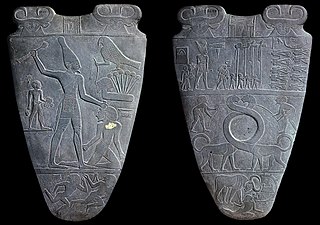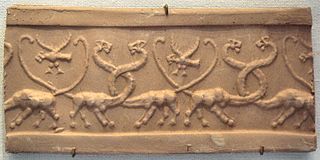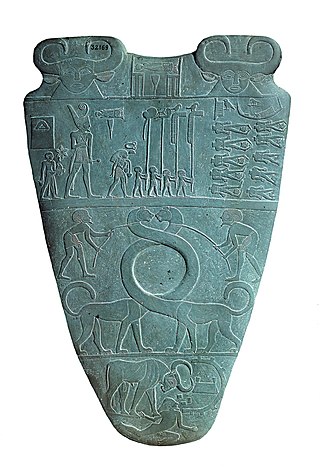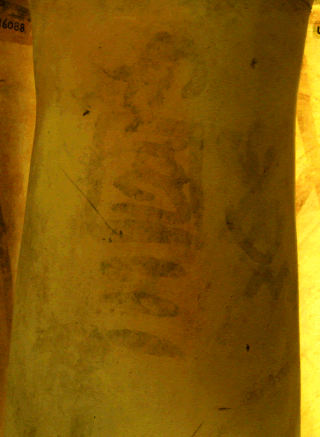
The First Dynasty of ancient Egypt covers the first series of Egyptian kings to rule over a unified Egypt. It immediately follows the unification of Upper and Lower Egypt, possibly by Narmer, and marks the beginning of the Early Dynastic Period, when power was centered at Thinis.

Narmer was an ancient Egyptian pharaoh of the Early Dynastic Period. He was the successor to the Protodynastic king Ka. Many scholars consider him the unifier of Egypt and founder of the First Dynasty, and in turn the first king of a unified Egypt. He also had a prominently noticeable presence in Canaan, compared to his predecessors and successors. A majority of Egyptologists believe that Narmer was the same person as Menes. Neithhotep is thought to be his queen consort or his daughter.

The Narmer Palette, also known as the Great Hierakonpolis Palette or the Palette of Narmer, is a significant Egyptian archaeological find, dating from about the 31st century BC, belonging, at least nominally, to the category of cosmetic palettes. It contains some of the earliest hieroglyphic inscriptions ever found. The tablet is thought by some to depict the unification of Upper and Lower Egypt under the king Narmer. Along with the Scorpion Macehead and the Narmer Maceheads, also found together in the main deposit at Nekhen, the Narmer Palette provides one of the earliest known depictions of an Egyptian king. On one side, the king is depicted with the bulbed White Crown of Upper (southern) Egypt, and the other side depicts the king wearing the level Red Crown of Lower (northern) Egypt, which also makes it the earliest known example of a king wearing both types of headdress. The Palette shows many of the classic conventions of Ancient Egyptian art, which must already have been formalized by the time of the Palette's creation. The Egyptologist Bob Brier has referred to the Narmer Palette as "the first historical document in the world".

Nekhen, also known as Hierakonpolis was the religious and political capital of Upper Egypt at the end of prehistoric Egypt and probably also during the Early Dynastic Period.
The Early Dynastic Period, also known as Archaic Period or the Thinite Period, is the era of ancient Egypt that immediately follows the unification of Upper and Lower Egypt in c. 3150 BC. It is generally taken to include the First Dynasty and the Second Dynasty, lasting from the end of the archaeological culture of Naqada III until c. 2686 BC, or the beginning of the Old Kingdom. With the First Dynasty, the Egyptian capital moved from Thinis to Memphis, with the unified land being ruled by an Egyptian god-king. In the south, Abydos remained the major centre of ancient Egyptian religion; the hallmarks of ancient Egyptian civilization, such as Egyptian art, Egyptian architecture, and many aspects of Egyptian religion, took shape during the Early Dynastic Period.

Scorpion II, also known as King Scorpion, was a ruler during the Protodynastic Period of Upper Egypt.

Iry-Hor was a predynastic pharaoh of Upper Egypt during the 32nd century BC. Excavations at Abydos in the 1980s and 1990s and the discovery in 2012 of an inscription of Iry-Hor in Sinai confirmed his existence. Iry-Hor is the earliest ruler of Egypt known by name and is sometimes cited as the earliest-living historical person known by name.

Hedjet is the White Crown of pharaonic Upper Egypt. After the unification of Upper and Lower Egypt, it was combined with the Deshret, the Red Crown of Lower Egypt, to form the Pschent, the double crown of Egypt. The symbol sometimes used for the White Crown was the vulture goddess Nekhbet shown next to the head of the cobra goddess Wadjet, the uraeus on the Pschent.

James Edward Quibell was a British Egyptologist.
Frederick William Green was an English Egyptologist, who worked at a number of sites throughout Egypt.

The serpopard is a mythical animal known from ancient Egyptian and Mesopotamian art. The word "serpopard" is a modern coinage. It is a portmanteau of "serpent" and "leopard", derived from the interpretation that the creature represents an animal with the body of a leopard and the long neck and head of a serpent. However, they have also been interpreted as "serpent-necked lions". There is no known name for the creature in any ancient texts.

Naqada III is the last phase of the Naqada culture of ancient Egyptian prehistory, dating from approximately 3200 to 3000 BC. It is the period during which the process of state formation, which began in Naqada II, became highly visible, with named kings heading powerful polities. Naqada III is often referred to as Dynasty 0 or the Protodynastic Period to reflect the presence of kings at the head of influential states, although, in fact, the kings involved would not have been a part of a dynasty. In this period, those kings' names were inscribed in the form of serekhs on a variety of surfaces including pottery and tombs.
The Amratian culture, also called Naqada I, was an archaeological culture of prehistoric Upper Egypt. It lasted approximately from 4000 to 3500 BC.

The Scorpion macehead is a decorated ancient Egyptian macehead found by British archeologists James E. Quibell and Frederick W. Green in what they called the main deposit in the temple of Horus at Hierakonpolis during the dig season of 1897–1898. It measures 25 centimeters long, is made of limestone, is pear-shaped, and is attributed to the pharaoh Scorpion due to the glyph of a scorpion engraved close to the image of a king wearing the White Crown of Upper Egypt.

The Gebel el-Arak Knife, also Jebel el-Arak Knife, is an ivory and flint knife dating from the Naqada II period of Egyptian prehistory, showing Mesopotamian influence. The knife was purchased in 1914 in Cairo by Georges Aaron Bénédite for the Louvre, where it is now on display in the Sully wing, room 633. At the time of its purchase, the knife handle was alleged by the seller to have been found at the site of Gebel el-Arak, but it is today believed to come from Abydos.
The Manshiyat Ezzat Palette is an ornately adorned schist cosmetic palette from predynastic Egypt found at a cemetery in the eastern Delta town of Manshiyat Ezzat, Dakahlia Governorate. The gravesite is from Pharaoh Den's reign, First Dynasty of Egypt. The palette is of low to moderate bas relief.

Neithhotep or Neith-hotep was an ancient Egyptian queen consort who lived and ruled during the early First Dynasty. She was once thought to be a male ruler: her outstandingly large mastaba and the royal serekh surrounding her name on several seal impressions previously led Egyptologists and historians to the erroneous belief that she might have been an unknown king. As the understanding of early Egyptian writings developed, scholars learned that Neithhotep was in fact a woman of extraordinary rank. She was subsequently considered to be the wife of unified Egypt's first pharaoh, Narmer, and the mother of Hor-Aha.

A sandal-bearer is a person who bears the sandals of his superior. The role existed in various cultures and epochs, being first documented in Egypt's Early Dynastic Period.

Crocodile is the provisional name of a predynastic ruler, who might have ruled during the late Naqada III epoch. The few alleged ink inscriptions showing his name are drawn very sloppily, and the reading and thus whole existence of king "Crocodile" are highly disputed. His tomb is unknown.

Wash was possibly a pharaoh from the Predynastic Period in Ancient Egypt, approximately 5,000 years ago. As Wash is known only through his appearance as a captive of the pharaoh Narmer on the eponymous palette, his existence is contested.




















